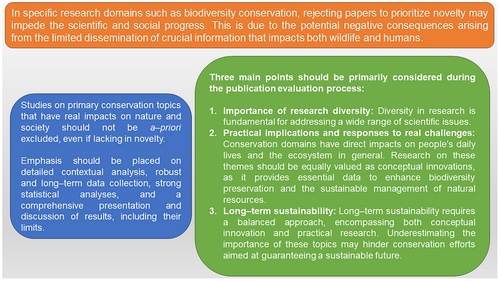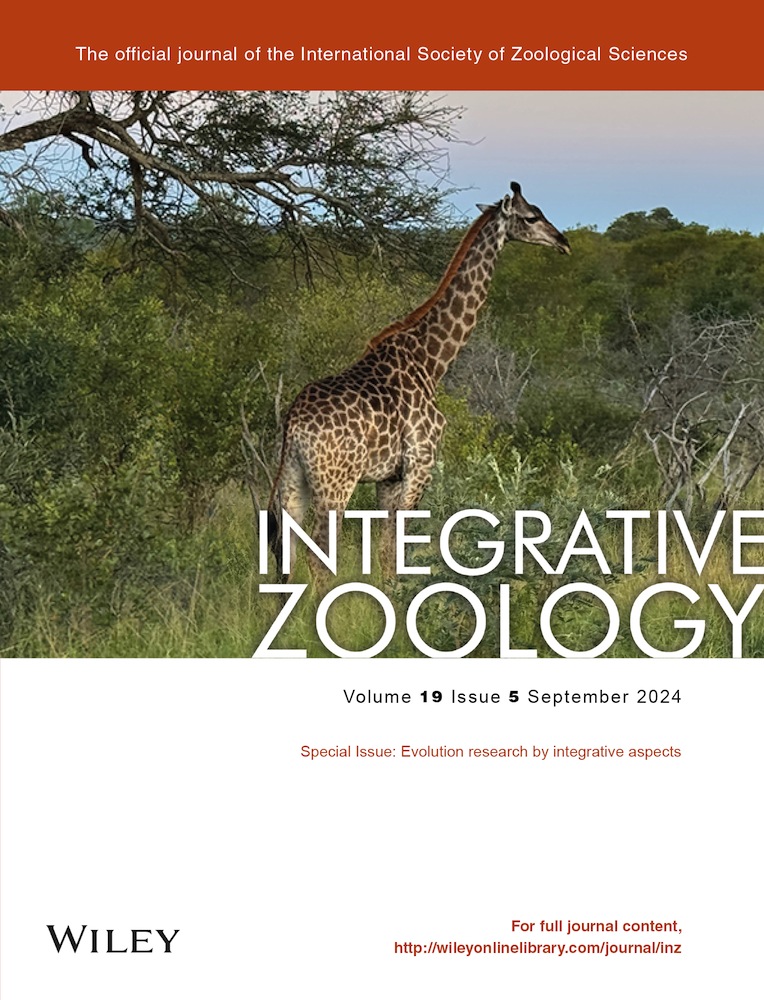The debatable notion of “novelty deficiency” in significant conservation domains
[Correction added on July 23, 2024 after first online publication: The copyright line was changed, the legal statement and the CRUI-CARE funding statement has been added.]
Graphical Abstract
In significant conservation domains, rejecting papers to prioritize novelty, may impede scientific and social progress as these studies carry crucial policy and practical implications. The research's rigor (rather than novelty) should be the primary criterion for evaluating the works’ robustness and suitability for publication. Innovation is essential, but science requires a balanced approach, encompassing both conceptual innovation and practical research.
INTRODUCTION
“I apologize. Despite your research contains some valuable information, it does not contribute sufficient novelty to be considered as publishable in this journal”—from a response letter received by the author after the straightforward rejection of a manuscript dealing with conservation dimensions.
In today's scientific world, there is a heightened emphasis on pursuing “novel” research, which places a constant and pressing demand on researchers. The term “novelty,” often lacking a clear definition, is frequently equated with the quality of research excellence (Cohen 2017). Review panels tend to label research as lacking novelty when it expands on existing hypotheses rather than developing entirely new ones or exploring a wide spectrum of theories, even if expanding on existing hypotheses into new realms requires creativity and dedication (Cohen 2017). Karl Popper and Thomas Kuhn, two of the most influential philosophers of science, emphasized that scientists must pursue their hypotheses. Popper argued that hypotheses, even if surviving numerous empirical challenges, can never be conclusively proven and should remain subject to continual testing. Moreover, he advocated for discarding a theory as soon as it was falsified. Conversely, Kuhn proposed the “flexibility of paradigms,” suggesting that only a critical mass of anomalies warrants a paradigm shift, hence leading to a theory rejection (Cohen 2017). Nevertheless, both philosophies stressed continuity over novelty. The “lack of novelty” is one of the most common reasons for paper rejections at the desk or post-editorial phases (Menon et al. 2022). However, overemphasizing novelty in research can adversely impact science in several ways. Rushed publications, encouraged by the pursuit of novelty, may lead to less accurate and shorter-term data collection, thereby compromising the quality of research. Long-term studies, on the other hand, are crucial as they provide a more comprehensive overview and allow for a better understanding of the phenomenon under study due to the availability of data collected over an extended period. Long-term studies also ensure better validity and reproducibility of findings and improvement in the accuracy of scientific predictions. Furthermore, funding agencies, faced with limited resources, seek a balance between novelty and feasibility, potentially disadvantaging novel research (Alberts et al. 2014).
The problem of paper rejections due to a lack of novelty seriously impedes scientific progress (Arnqvist 2013; Cohen 2017). Furthermore, in specific research domains such as nature, biodiversity, and/or ecosystem conservation, prioritizing novelty in paper selection may hinder both scientific and social progress. This is due to the potential negative consequences arising from the limited dissemination of crucial information that impacts both wildlife and humans. The interplay between the human–wildlife dimension, the impacts of climate change on biodiversity, the influence of invasive alien species on ecosystems, and habitat restorations have garnered attention from both the media and the scientific community for years. Investigations in these areas provide the groundwork for shaping policies, adopting practices, and implementing tangible actions that promote environmental sustainability and contribute to the welfare of future generations. Despite numerous studies conducted in these domains, further research is fundamental to confront global challenges and ensure the preservation of ecosystems and human well-being.
While the issues/reasons of paper rejection due to a lack of novelty has been discussed in medical/molecular fields (Cohen 2017; Menon et al. 2022; Kumar et al. 2023), the potential serious negative consequences that may arise when dealing with conservation domains are, to my knowledge, still widely overlooked. Here, I provided a brief state of the art and highlighted why, despite the (real or perceived) lack of novelty, it is scientifically essential to continue valuing further studies on these significant conservation realms.
Primary conservation domains involving wildlife and humans
The human–wildlife conflict stands as a primary factor contributing to the decline of several wild species across the globe (Treves & Karanth 2003). This conflict also jeopardizes human well-being leading to the abandonment of human practices (i.e. agriculture, livestock husbandry) in intense conflict-prone areas (Franchini et al. 2021). These adverse interactions are particularly pronounced in developing countries, where livestock/farming practices often form the mainstay of livelihood of local communities (e.g. Augugliaro et al. 2020). Large and medium-sized carnivores/herbivores are involved in conflicts with humans mainly in the form of vehicle collisions (e.g. D'Amico et al. 2015; Frangini et al. 2022), attacks toward humans (e.g. Panteriani et al. 2016; Bombieri et al. 2023), livestock predations (e.g. Guerisoli et al. 2017, 2021; Franchini & Guerisoli 2023), and agricultural damages (e.g. Snyder et al. 2021; Ding et al. 2023; Cecchini et al. 2024). The retaliation stands among those strategies used by humans to mitigate the impact of these adverse interactions (e.g. Guerisoli et al. 2017; Soofi et al. 2022), in turn imperiling the ecosystems’ stability through wildlife population declines or local extinctions (Ripple et al. 2014, 2015). Although humans bear responsibility for biodiversity decline (e.g. Banks-Leite et al. 2020), extensive livestock practices provide essential ecosystem services (e.g. food, climate regulation, carbon sequestration, nutrient recycling) and contribute to landscape and biodiversity preservation (Battaglini et al. 2014; Salvador et al. 2017; Pachoud et al. 2020). The abandonment of extensive livestock practices in regions with heightened conflicts thereby contributes to further exacerbating environmental degradation.
Climate change is one of the major causes of biodiversity decline worldwide (e.g. Bellard et al. 2012; Pacifici et al. 2015; Urban 2015), largely affecting wild species’ habitats, compositions, and geographic distribution (Bellard et al. 2012; Nunez et al. 2019; Lovari et al. 2020). When the climate is no longer suitable, some species may shift their geographic distribution or face local extinction, in turn altering ecosystem functioning (Bellard et al. 2012; Nunez et al. 2019; Lovari et al. 2020). Climate change also has adverse consequences on humans (McMichael et al. 2006) in the form of extreme weather events (e.g. torrential rains, flooding, droughts, storms, high temperatures) (McMichael et al. 2006), earthquakes (Celik 2020), emergence of illnesses, spread of diseases, alterations in land structure, and economic losses due to the decrease in the yield of agricultural products (McMichael et al. 2006; Celik 2020). All these factors cause distress in people (McMichael et al. 2006), ultimately forcing them to migrate, become homeless, get injured, or lose their lives (Celik 2020).
Biological invasions are one of the key human-induced drivers affecting biodiversity and human livelihood (Pejchar & Mooney 2009; Vilà & Hulme 2016). The abundance and distribution of invasive alien species (herein, invasive species) have been increasing in many countries (Seebens et al. 2017), and the costs associated with their presence (e.g. Pimentel et al. 2005; Kettunen et al. 2008) are likely underestimated and expected to increase (Bradshaw et al. 2016). Invasive species, through direct competition for resources, lead to indigenous population declines or local extinctions (Atkinson 1996). Moreover, while some invasive species provide economic/ecosystem benefits to humans (Shackleton et al. 2019), others negatively affect human well-being through induced stressors, for example, natural disasters, the spread of diseases, reduced supply of natural resources, and economic losses (Palmer et al. 2014; Rijal & Cochard 2016; Shackleton et al. 2019).
Habitat loss/degradation stands among the main causes leading to biodiversity decline on a planetary scale (Banks-Leite et al. 2020). Many ecosystems globally, having suffered severe damages or destructions, cannot recover without restoration efforts (McDonald et al. 2016; Hughes et al. 2018). Restoration is a crucial component of the Convention on Biological Diversity Strategic Plan (Hughes et al. 2018; Trouwborst & Svenning 2022) as it enables the regeneration of degraded habitats, enhances biological diversity, provides ecosystem services beneficial to humans (MA 2005; Wortley et al. 2013), and counteracts the effects of climate change (Suding et al. 2015).
CONCLUSIONS AND FUTURE PERSPECTIVES
-
Importance of research diversity: Diversity in research is fundamental for addressing a wide range of scientific issues. Research innovation is essential, but it should not exclude studies on key topics that have real impacts on nature and society.
-
Practical implications and responses to real challenges: Research on conservation domains having direct impacts on people's daily lives and ecosystems should be equally valued as conceptual innovations, as it provides essential data to enhance biodiversity preservation and the sustainable management of natural resources. Rejecting research on these topics due to lack of novelty could hinder the development of practical strategies to address crucial environmental challenges.
-
Long-term sustainability: Long-term sustainability requires a balanced approach, encompassing both conceptual innovation and practical research. Underestimating the importance of these topics may hinder conservation efforts aimed at guaranteeing a sustainable future.
The purpose of this research was neither to assert that novelty is the primary reason for paper rejections by influential journals (in fact, papers face rejection for various reasons, with novelty being just one of them) nor advocate for automatic acceptance even if studies, despite the methodological rigor, replicate existing works (e.g. conducted in the same area, during the same period, and using identical methods). Some journals explicitly target more novel findings while others offer more flexibility. Therefore, regardless of novelty, it is possible to publish good results if methods are not flawed and appropriate journals are found. Nevertheless, despite their potentially important implications, studies lacking perceived novelty may struggle to gain traction in highly impacted journals, sometimes finding placement only in second- or third-tier journals (Cohen 2017). Research published in less-impacted journals, however, might receive less attention compared to that published in highly impacted ones. As a result, this may restrict the dissemination of important pieces of knowledge. Although novelty holds significance in science, the research's rigor should be considered the primary criterion for evaluating the work's robustness and suitability for publication, particularly when studies carry significant policy and practical implications. As long as the scientific method remains sound, there is an inherent value that warrants consideration. These principles hold relevance also across other conservation domains not directly affecting human livelihoods, for example, the impact of both domestic cats (Mori et al. 2019) and dogs (Sogliani et al. 2023) on native wildlife.
In conclusion, I suggest that the emphasis placed on novelty in conservation sciences should be reconsidered. Rejecting scientific articles on important (despite, maybe, less innovative) topics can compromise the completeness of scientific knowledge and hamper efforts to address the real challenges that our planet and society face today. Scientific research should be balanced, reflecting the complexity of the real world and thereby contributing to broader and more sustainable scientific progress.
ACKNOWLEDGMENTS
Open access publishing facilitated by Universita degli Studi di Udine, as part of the Wiley - CRUI-CARE agreement.
CONFLICT OF INTEREST STATEMENT
The author declares no conflict of interest.





